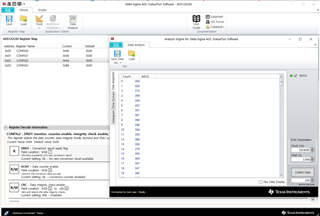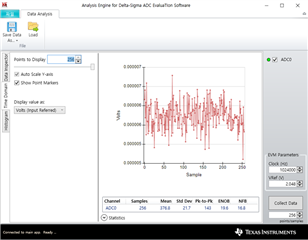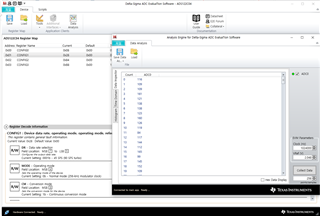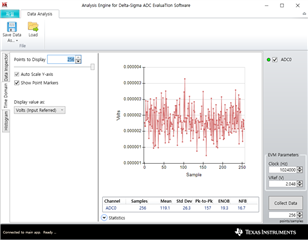Other Parts Discussed in Thread: ADS122C04, ADS112C04
While developing the product through ADS122c04, there was DATA hunting according to the SPS, so the same test was conducted using the EVM board, and the same hunting occurred on the EVM board.
I think the same data range should come out even if the SPS changes, but it is not.
I used Delta-Sigma ADC Evaluation Software.
Why are the data results different?
Below is my data.
1. 20SPS


Register 0 = 0x08 MUX[3.0]=b0000(+:AIN0,-:AIN1), GAIN=b100(x16), PGA=b0(Enable)
Register 1 = 0x08 DR[2.0]=b000(Data Rate:20sps), MODE=b0(Normal), CM=b1(Continuous), VREF=b00(2.048V), TS=0(disable)
Register 2 = 0x04 DRDY=b0, CNBT:b0, CRC:b00, BCS:b0, IDAC=b100(250uA)
Register 3 = 0xB8 I1MUX[2.0]=b101(IDAC1=REFP), I2MUX[2.0]=b110(IDAC2=REFN), reserved=b00
2) 45SPS


Register 0 = 0x08 MUX[3.0]=b0000(+:AIN0,-:AIN1), GAIN=b100(x16), PGA=b0(Enable)
Register 1 = 0x28 DR[2.0]=b001(Data Rate:45sps), MODE=b0(Normal), CM=b1(Continuous), VREF=b00(2.048V), TS=0(disable)
Register 2 = 0x84 DRDY=b1, CNBT:b0, CRC:b00, BCS:b0, IDAC=b100(250uA)
Register 3 = 0xB8 I1MUX[2.0]=b101(IDAC1=REFP), I2MUX[2.0]=b110(IDAC2=REFN), reserved=b00

